Posted by James (admin) on July 14th, 2013
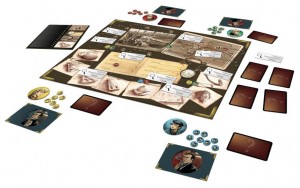 In Lady Alice, players are the kids on Baker Street who are trying to solve the kidnapping of explorer Stanley with Sherlock Holmes’s guidance. With that said, you’ll be unsurprised that Lady Alice is a deduction game.
In Lady Alice, players are the kids on Baker Street who are trying to solve the kidnapping of explorer Stanley with Sherlock Holmes’s guidance. With that said, you’ll be unsurprised that Lady Alice is a deduction game.
A crime has been committed and there are 4 pieces of information (categories) to work out: Where, Who, When and What. There are 8 different possibilities (clues) in each of the 4 categories (and there’s a card for each of the 32 clues). In the middle of the table is a board which shows Sherlock Holmes’s desk where all of the clues are displayed. (I’ll describe how the game plays with 4 players as it’s the most straightforward.)
At the start of the game, one card from each of the 4 categories is randomly drawn face-down – these 4 cards are the solution to the crime which are shuffled up and each player is dealt one at random. So, each player holds one of the 4 pieces of evidence and players don’t even know which category each of the other players holds. Read the rest of this entry »
Tags: board game news, Board Games, board gaming, Hurrican, Lady Alice
Posted in Board Game Review, Board Games, Lady Alice | No Comments »
Posted by James (admin) on July 11th, 2013
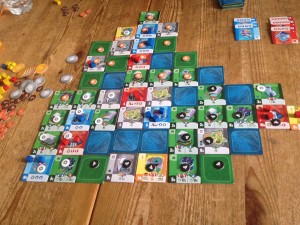
In City Tycoon, players are building different building tiles in the same city. The player with the most victory points (VPs) when the game ends after 4 rounds is the winner. The city starts with several fixed tiles in the middle including a small power and small water plant which are neutral.
Each of the 4 rounds is split into 3 main phases: Selecting tiles, Building/Selling tiles, and Activating tiles. The tile selecting phase starts with each player being dealt 6 building tiles – players look at them, keep 1 tile and pass the rest to the player on their left. This process happens 6 times with each player picking 1 tile from those they were passed, so each player ends with 6 tiles, as well as knowledge of what other tiles other players will have this round.
During the building/selling tiles phase, players take turns using 1 building tile from their hand in one of 3 ways:
- Build: The player pays the cost of the tile, places the tile in the city (next to any existing tile) and places a marker on it to show they own it. (Some buildings even generate cash, VPs, etc. when they are built too.)
- Sell: The player discards the tile and receives $5.
- Plant: The player discards the tile and can build the next available power or water generating plant tile (paying the cost marked on the plant tile and placing a marker on it to show they own it).
Finally, players take turns activating one of the building tiles they own to gain the benefit shown on the tile. Read the rest of this entry »
Tags: board game news, Board Games, board gaming, City Tycoon, Essen, Rebel.pl, Spiel 2012
Posted in Board Game Review, Board Games, City Tycoon, Essen Spiel 12 | No Comments »
Posted by James (admin) on June 19th, 2013
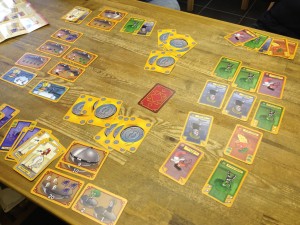 We Will Wok You is a quick card-game for 2-4 players. The theme is that the players are providing food at a music concert. On the table are recipe cards and ingredient cards. Each ingredient card shows one ingredient as well as one or two symbols (bowl, chopsticks, etc.) Recipe cards show how the player that owns the card can score victory points (VPs) at the end of the game and the player with the most VPs wins.
We Will Wok You is a quick card-game for 2-4 players. The theme is that the players are providing food at a music concert. On the table are recipe cards and ingredient cards. Each ingredient card shows one ingredient as well as one or two symbols (bowl, chopsticks, etc.) Recipe cards show how the player that owns the card can score victory points (VPs) at the end of the game and the player with the most VPs wins.
At the start of the game, 4 coin cards are placed next to 2 rows of 2 ingredient cards, and 6 coin cards are placed next to 2 rows of 3 ingredient cards – the coins indicate the price of the rows that they are next to. On their turn, a player must do one of three actions:
Buy ingredients: The player pays coins equal to the number of coins next to the row purchased. New ingredient cards are drawn to replace the bought row and the spent coins are added to the price. As a result, buying a row of ingredients raises the price of the ones that replace those bought as well as the other row of the same length.
Take a coin: The player takes one of the coin cards that show the prices of the ingredients. Taking a coin means some ingredients will be cheaper for the next players.
Gain a recipe card: The player places cards from their hand onto the table which have a total of 4 matching symbols (the ingredients on the cards are not important for this) and this allows the player to take any one of the remaining recipe cards. Read the rest of this entry »
Tags: board game news, Board Games, board gaming, Pegasus Spiele, We Will Wok You
Posted in Board Game Review, Board Games, We Will Wok You | No Comments »
Posted by James (admin) on June 13th, 2013
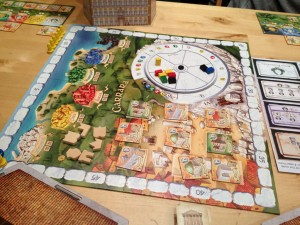 The Palaces of Carrara first caught my attention because it’s a Eurogame by veterans Wolfgang Kramer and Michael Kiesling (Tikal, Tikal II, Asara). Also, the Palaces of Carrara has been nominated for the 2013 Spiel des Jahres Kennerspiel.
The Palaces of Carrara first caught my attention because it’s a Eurogame by veterans Wolfgang Kramer and Michael Kiesling (Tikal, Tikal II, Asara). Also, the Palaces of Carrara has been nominated for the 2013 Spiel des Jahres Kennerspiel.
Players buy coloured marble which they use to build buildings in the 6 cities. The player with the most victory points (VPs) at the end of the game is the winner. This may sound very ordinary, but there are several clever game mechanics that combine really well and deliver a tight and tense game.
On their turn, a player can either buy marble, build a building, or score.
Buying Marble
On the board is a rotating disc (split into 6 segments). Around the disc are 6 sets of prices for the different marble colours – white is most expensive, then yellow, then red, and so on. When buying marble, the player turns the wheel one section clockwise and draws marble blocks from the bag to bring the total on the wheel up to 11 (placing new blocks in the most expensive segment). The player can then buy any number of marble blocks but only from one single segment of the wheel. The costs are marked next to each segment and these get cheaper (even free) as blocks progress around the wheel. Read the rest of this entry »
Tags: Asara, board game news, Board Games, board gaming, Hans im Glück, Michael Kiesling, SdJ, Spiel des Jahres, The Palaces of Carrara, Tikal, Tikal II, Wolfgang Kramer, Z-Man Games
Posted in Board Game Review, Board Games, The Palaces of Carrara | No Comments »
Posted by James (admin) on June 11th, 2013
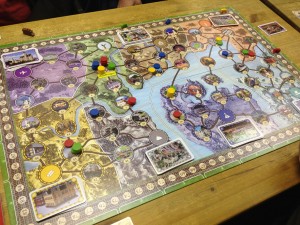 Wunderland is a game set at the massive, real-world, model village in Germany which covers 1,300 square metres. Players aim to earn the most victory points (VPs) by completing destination tickets and collecting postcards – the player with the most VPs at the game’s end wins.
Wunderland is a game set at the massive, real-world, model village in Germany which covers 1,300 square metres. Players aim to earn the most victory points (VPs) by completing destination tickets and collecting postcards – the player with the most VPs at the game’s end wins.
Each player has 8 visitor tokens and these all start on the main start space. The board shows lots of numbered spaces (locations) which are linked by various pathways and are located in 8 different regions (such as Hamburg, Austria, Scandinavia, USA). On their turn, a player can move any number of their visitors from one single location to another location that is 1 or 2 locations away (so a player can leave some of their visitors behind if they want); then, each other player can choose to move some of their visitors with those that were moved (if they had any on the same location).
This is a nice and simple game mechanic. Players can move their visitors quite quickly if they tag along with each others’ visitors, but players can also go their own way and be on their own spaces so they don’t benefit anyone else when they move. It’s a double-edged sword – you don’t want to help other players move towards their goals, but you want to tag along with other players when they move. Also, this game mechanic keeps the game flowing very quickly (as a turn is short) and there is very little downtime (as players are very often involved in moves when it isn’t their turn). Read the rest of this entry »
Tags: board game news, Board Games, board gaming, Pegasus, Pegasus Spiele, Wunderland
Posted in Board Game Review, Board Games, Wunderland | No Comments »
Posted by James (admin) on June 7th, 2013
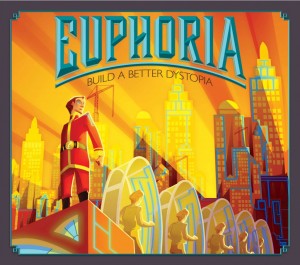 Some months ago, I posted about the wine-making game Viticulture which was being Kickstarted (and I will be reviewing that soon). The same designers at StoneMayer Games are Kickstarting their new game at the moment called Euphoria.
Some months ago, I posted about the wine-making game Viticulture which was being Kickstarted (and I will be reviewing that soon). The same designers at StoneMayer Games are Kickstarting their new game at the moment called Euphoria.
Euphoria is set in a dystopian future and is a game of worker placement. Workers are dice whose values are set by rolling them when you gain them or retrieve them from the board. High value dice can be handy because some locations give a benefit based on the sum of the workers there; however, the numbers represent the worker’s knowledge of the world around them and too much knowledge on your workers who aren’t currently placed means they become too aware of their reality and run away.
On their turn, players can either place workers (one at a time, or more if the workers have matching values) or they can remove workers, but never both. Placing workers allows players to use various actions which usually earn resources or allow a player to spend resources to gain things like workers, etc.
However, there are a few different types of area where workers can be placed. For example, in some areas, workers don’t get returned to their owner until another worker is placed on the same area (which makes me think there may be opportunities to return a worker to another player specifically to try and cause them to run away if that player has several high-value, unplaced workers already). Another example is that some areas can have any number of workers present on them and the benefit gained from placing a worker there is based on the total sum of the workers’ values. These sound like nice additions to the usual worker placement mechanic. Read the rest of this entry »
Tags: board game news, Board Games, board gaming, Euphoria, Kickstarter, Viticulture
Posted in Board Games, Euphoria, On the Radar, Viticulture | No Comments »
Posted by James (admin) on June 6th, 2013
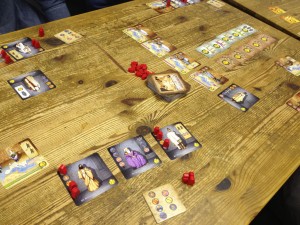 Augustus is one of this year’s nominees for the Spiel des Jahres (the largest board games award). It is designed by Paolo Mori who designed Libertalia and (one of my favourite games) Vasco de Gama. In fact, Paolo seems to be designing more and more at the moment.
Augustus is one of this year’s nominees for the Spiel des Jahres (the largest board games award). It is designed by Paolo Mori who designed Libertalia and (one of my favourite games) Vasco de Gama. In fact, Paolo seems to be designing more and more at the moment.
Players always have 3 objective cards and each can be completed by placing one of their legions (meeples) onto each of an objective’s symbols (sword, shield, chariot, etc.) Each turn, one player (the town crier) randomly draws one symbol from the bag. Then, every player can place one of their legions onto a matching symbol if they have a vacant one on one of their objectives – the placed legion can be from their supply, or they can move a legion which is already placed on an objective. So, if a sword symbol is drawn a player can place a legion from their supply, or from another objective, onto an empty sword icon.
There is a known mixture of symbols in the bag and there are more of some symbols than others, i.e. 6 swords, 5 shields, 4 chariots, etc. Therefore, whilst it’s a random draw, some symbols are more likely to be drawn than others. There are also 2 wild (joker) symbols in the bag – when one of these is drawn, players can place a legion on any one symbol, plus all of the previously drawn symbols are put back in the bag, and the town crier moves on to the next player. Read the rest of this entry »
Tags: Augustus, board game news, Board Games, board gaming, Hurrican, Paolo Mori, SdJ, Spiel des Jahres
Posted in Augustus, Board Game Review, Board Games | No Comments »
Posted by James (admin) on June 1st, 2013
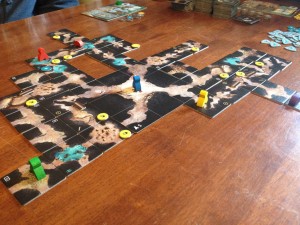
The Cave is by the same designer who created the mountain climbing game, K2. This time players are trying to get the most victory points (VPs) by exploring the depths of an underground cave system, taking the best photos, reaching the deepest depths, and so on. However, players have a very limited amount of space to carry their equipment like rope, food, water, etc. and must balance what they need for survival and what they need to explore.
All players start at home base and each player has a player board showing the 8 spaces in their backpack where they place the tokens representing the equipment they are carrying. One of the most important items to carry are consumables (food/drink) because a player must first discard one of their consumables before they do anything else on their turn. If a player doesn’t have any consumables then they must spend their entire turn moving one tile and can do nothing else and can gain no VPs. So, miscalculating how long you can stay in the caves before going back to resupply can really hinder you.
The cave system starts with the large home base cave tile in the centre of the table and the cave network will be created as players explore by drawing and adding new tiles. When the tiles run out, players each get 3 more turns and then the game ends; however, be warned, anyone not back at base camp by the end is automatically eliminated.
Read the rest of this entry »
Tags: board game news, Board Games, board gaming, K2, The Cave
Posted in Board Game Review, Board Games, The Cave | No Comments »
Posted by James (admin) on May 31st, 2013
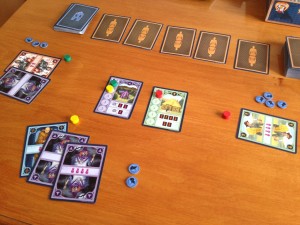 Rattus Cartus is a card game set in the world of medieval plague as is its sibling game, Rattus. It should make it clear that Rattus Cartus is not a card game version of the original Rattus game as, whilst is uses the same theme and art style, it has its own game mechanics.
Rattus Cartus is a card game set in the world of medieval plague as is its sibling game, Rattus. It should make it clear that Rattus Cartus is not a card game version of the original Rattus game as, whilst is uses the same theme and art style, it has its own game mechanics.
The goal is to earn the most victory points (VPs). At the end of the game, players score VPs based on how much influence they have with each of the 6 different character classes (10 VPs for having the most, 5Vps for 2nd most, and 2 VPs for third most influence). Some other VPs can be earned during the game too.
The game primarily comprises of character cards (6 types) and building cards (6 types each corresponding to a character). During set-up 5 random character cards are laid out face-down – each card has 0-4 nuns on it – and these are called the ‘nun’ cards. At the end of the game, any player who has more rats than the total number of nuns on these 5 cards is lost to the plague and automatically loses. Read the rest of this entry »
Tags: board game news, Board Games, board gaming, Essen, Rattus Cartus, Spiel 2012, White Goblin Games
Posted in Board Game Review, Board Games, Essen Spiel 12, Rattus Cartus | No Comments »
Posted by James (admin) on May 17th, 2013
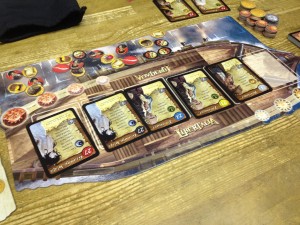 Libertalia is by Paolo Mori who designed one of my favourite games Vasco de Gama. Libertalia is a very different game to Vasco de Gama as it is a simple and relatively quick, card-playing game.
Libertalia is by Paolo Mori who designed one of my favourite games Vasco de Gama. Libertalia is a very different game to Vasco de Gama as it is a simple and relatively quick, card-playing game.
Players are pirate crews who are trying to earn the most doubloons buy collecting booty. Each player has a set of 30 cards each representing a crew member with a value (1-30), a special ability and a tie-break number. Each player’s set of cards is the same except the tie-break numbers are different so that no two cards are exactly the same. Each card’s special ability states if it will be used in the day, at dusk, at night, or at the end of the campaign. To start the 1st campaign, one player randomly draws 9 cards from their deck, then all the other players draw the same cards.
The game is played over 3 campaigns, each consisting of 6 days when players will play one card each. At the start of each campaign, booty tiles are drawn at random and placed on each of the 6 days on the board (one token per player). Most booty tokens are simply worth 1, 3 or 5 doubloons, although treasure maps are only worth 12 doubloons combined if you have at least 3 of them. There are also cursed booty tokens worth -3 doubloons, as well as saber and Spanish officer tokens which are worth no doubloons but have special effects (see below). Read the rest of this entry »
Tags: board game news, Board Games, board gaming, Libertalia, Paolo Mori, Vasco de Gama
Posted in Board Game Review, Board Games, Libertalia | No Comments »
 In Lady Alice, players are the kids on Baker Street who are trying to solve the kidnapping of explorer Stanley with Sherlock Holmes’s guidance. With that said, you’ll be unsurprised that Lady Alice is a deduction game.
In Lady Alice, players are the kids on Baker Street who are trying to solve the kidnapping of explorer Stanley with Sherlock Holmes’s guidance. With that said, you’ll be unsurprised that Lady Alice is a deduction game.



 The Palaces of Carrara first caught my attention because it’s a Eurogame by veterans Wolfgang Kramer and Michael Kiesling (Tikal,
The Palaces of Carrara first caught my attention because it’s a Eurogame by veterans Wolfgang Kramer and Michael Kiesling (Tikal, 

 Augustus is one of this year’s nominees for the Spiel des Jahres (the largest board games award). It is designed by Paolo Mori who designed Libertalia and (one of my favourite games) Vasco de Gama. In fact, Paolo seems to be designing more and more at the moment.
Augustus is one of this year’s nominees for the Spiel des Jahres (the largest board games award). It is designed by Paolo Mori who designed Libertalia and (one of my favourite games) Vasco de Gama. In fact, Paolo seems to be designing more and more at the moment.

